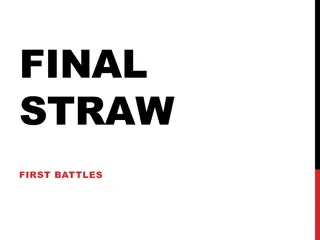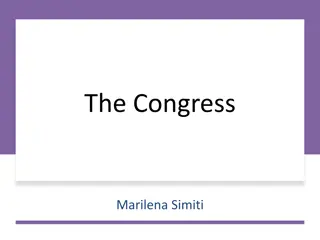The Road to Revolution: Actions of Parliament and Continental Congress
The events leading to the American Revolution, including the actions of Parliament and the Continental Congress, are highlighted in this chapter. It covers the issues facing the 2nd Continental Congress, the differences between Patriots and Loyalists, the failure of the Olive Branch Petition, and the significance of the Battle of Bunker Hill. Key terms and people related to this period are also discussed, illustrating the division among colonists and the steps taken towards independence.
Download Presentation

Please find below an Image/Link to download the presentation.
The content on the website is provided AS IS for your information and personal use only. It may not be sold, licensed, or shared on other websites without obtaining consent from the author.If you encounter any issues during the download, it is possible that the publisher has removed the file from their server.
You are allowed to download the files provided on this website for personal or commercial use, subject to the condition that they are used lawfully. All files are the property of their respective owners.
The content on the website is provided AS IS for your information and personal use only. It may not be sold, licensed, or shared on other websites without obtaining consent from the author.
E N D
Presentation Transcript
Chapter 5 The Road to Revolution 1745-1776 Section 4 The War Begins Pages 159-161 Section LEQ: How did the actions of Parliament and the Continental Congress contribute to the start of the American Revolution?
Key terms & People What you will know Blockade Patriots Thomas Jefferson Declaration of the Causes and Necessities Fort Ticonderoga Green Mountain Boys Benedict Arnold Mercenary Loyalists John Hancock Olive Branch Petition Ethan Allen Bunker Hill
What you will do 1. Identify the issues facing the 2nd Continental Congress 2. Describe the differences between the Loyalists and Patriots 3. Explain why the Olive Branch Petition failed 4. Examine the significance of the Battle of Bunker Hill 5. Identify and define key terms and people
Second Continental Congress New delegates Thomas Jefferson- VA John Hancock-Boston Benjamin Franklin-Philadelphia Steps taken: Form an army Chose George Washington as commander of army Print paper money to fund an army
Colonists Divided Patriots Supported colonial independence Loyalists Loyal to the British Parliament
Check on Learning 1. List the steps taken at the 2nd Continental Congress (3). 2. Patriots versus Loyalists. List one characteristic of each.
Fort Ticonderoga On May 10, 1775, Ethan Allen and 83 men, called the Green Mountain Boys captured Fort Ticonderoga. The men seized weapons, including cannons which were later moved to Boston.
Petitions to Britain These two resolutions showed the uncertainty among the colonists: 1. The Olive Branch Petition stated that colonists were loyal to the king they wanted peace. 2. The Declaration of the Causes and Necessities of Taking Up Arms stated that the colonists were ready to die for freedom.
Check on Learning 1. Who captured Fort Ticonderoga? 2. What petition stated that the colonists were loyal to the king? 3. The Declaration of the Causes and Necessities stated what about the colonists 4. Which petition was more likely written by loyalists?
2nd Continental Congress Olive Branch response
Bunker Hill page 159 The British won the battle of bunker hill after the third attack because the American militia ran out of ammunition. The battle proved that the Americans could fight and stand up to British soldiers.
Bunker Hill 1. Analyze the picture 2. What problem(s) are British troops facing? 3. What strategic advantage(s) do the Americans have? 4. What problem(s) might the Americans have? 5. Share your answers
Bunker Hill/Breeds Hill Battle of Bunker Hill
Canada In December 1775 one army led by Richard Montgomery another led by Benedict Arnold invaded Canada and attacked the city of Quebec. The attack failed.
Check on Learning 1. The British were able to win this battle after the 3rd attack? Why? 2. What two men led two American armies into Canada? 3. What was the outcome in the city of Quebec? 4. Define Blockade. 5. Define Mercenary. 6. Summary. In your own words, summarize what you learned in this section. 7. Answer the LEQ: Page 1 of your guided notes.
Class Activity Early Battles of the American Revolution worksheet Use your textbook and notes to complete
Homework Study for quiz Study for vocabulary words























